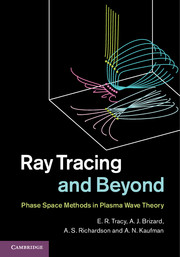Book contents
- Frontmatter
- Dedication
- Contents
- Preface
- Acknowledgements
- 1 Introduction
- 2 Some preliminaries
- 3 Eikonal approximation
- 4 Visualization and wave-field construction
- 5 Phase space theory of caustics
- 6 Mode conversion and tunneling
- 7 Gyroresonant wave conversion
- Appendix A Cold-plasma models for the plasma dielectric tensor
- Appendix B Review of variational principles
- Appendix C Potpourri of other useful mathematical ideas
- Appendix D Heisenberg–Weyl group and the theory of operator symbols
- Appendix E Canonical transformations and metaplectic transforms
- Appendix F Normal forms
- Appendix G General solutions for multidimensional conversion
- Glossary of mathematical symbols
- Author index
- Subject index
- References
5 - Phase space theory of caustics
Published online by Cambridge University Press: 05 April 2014
- Frontmatter
- Dedication
- Contents
- Preface
- Acknowledgements
- 1 Introduction
- 2 Some preliminaries
- 3 Eikonal approximation
- 4 Visualization and wave-field construction
- 5 Phase space theory of caustics
- 6 Mode conversion and tunneling
- 7 Gyroresonant wave conversion
- Appendix A Cold-plasma models for the plasma dielectric tensor
- Appendix B Review of variational principles
- Appendix C Potpourri of other useful mathematical ideas
- Appendix D Heisenberg–Weyl group and the theory of operator symbols
- Appendix E Canonical transformations and metaplectic transforms
- Appendix F Normal forms
- Appendix G General solutions for multidimensional conversion
- Glossary of mathematical symbols
- Author index
- Subject index
- References
Summary
In Chapter 3, we introduced the eikonal approximation for vector wave equations, and considered its application in various settings. Up to now we have postponed a discussion of situations where the approximation breaks down. The most common problems are caustics, tunneling, and mode conversions. These breakdowns are all local in x-space, but they have very different characteristics. Resolution of these three distinct problems require three different strategies, but all benefit from a phase space perspective. In this chapter, we consider caustics, and defer the discussion of tunneling and mode conversion to Chapter 6.
Caustics are associated with singularities that can arise locally when we project the Lagrange manifold of rays from its natural home in ray phase space down to x-space. This leads to a loss of good behavior of the eikonal phase in x-space, and a resulting nonphysical (infinite) prediction for the action density at the caustic. Caustics can result from focusing/refraction of neighboring rays, or their reflection near the plasma boundary, for example. This projection singularity leads to arbitrarily large components of ∂∂θ, and unphysical singularities of the wave amplitude along the ray through Eq. (3.57e). Near caustics, the eikonal approximation is no longer valid in x-space. A local asymptotic solution must be found and matched to the incoming and outgoing rays. This is most often done by transforming to k-space, where the solution is well-behaved.
The theory of caustics is intimately entwined with the stationary phase approximation. Away from caustics, the Fourier transform of an eikonal field is also an eikonal field, when the Fourier integral is evaluated using the stationary phase approximation.
- Type
- Chapter
- Information
- Ray Tracing and BeyondPhase Space Methods in Plasma Wave Theory, pp. 183 - 227Publisher: Cambridge University PressPrint publication year: 2014



